外研版(2019)必修第三册Unit 2 Making a Difference Using language 过去分词作定语课件(共20张PPT)
文档属性
| 名称 | 外研版(2019)必修第三册Unit 2 Making a Difference Using language 过去分词作定语课件(共20张PPT) |  | |
| 格式 | pptx | ||
| 文件大小 | 30.9MB | ||
| 资源类型 | 教案 | ||
| 版本资源 | 外研版(2019) | ||
| 科目 | 英语 | ||
| 更新时间 | 2024-05-18 09:54:32 | ||
图片预览

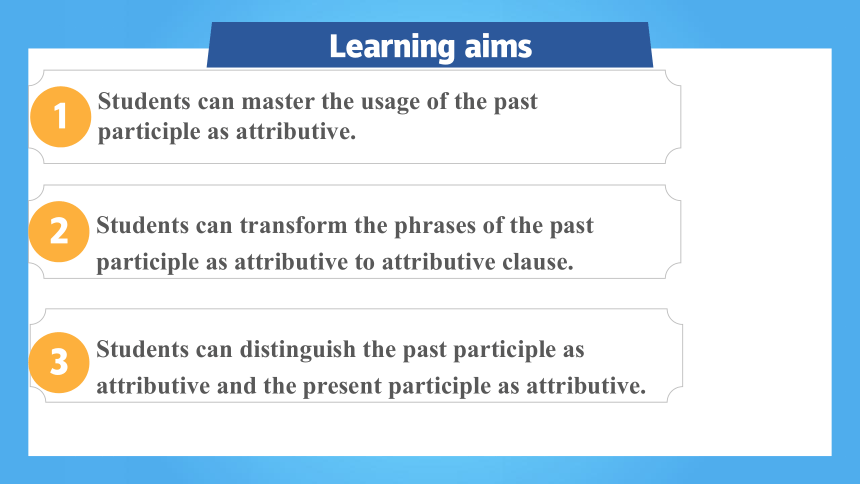
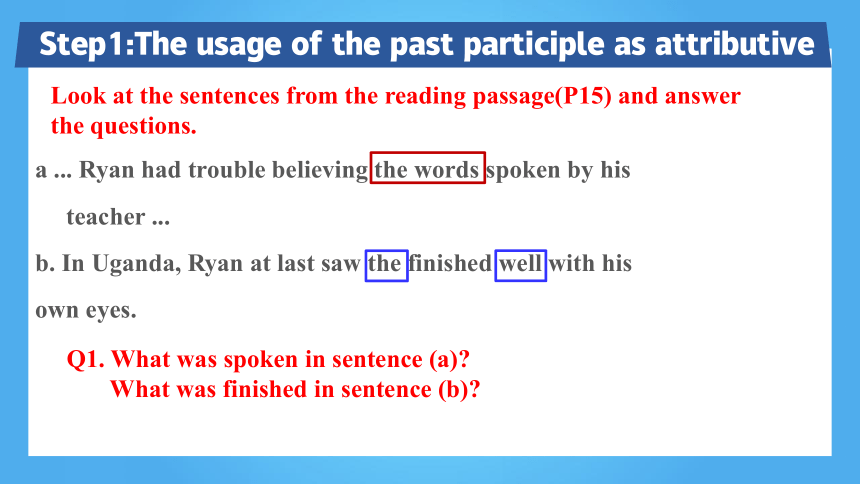
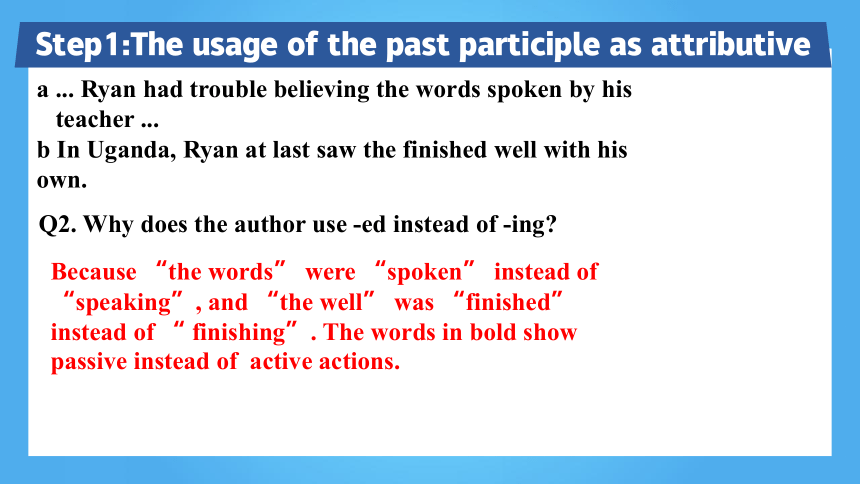
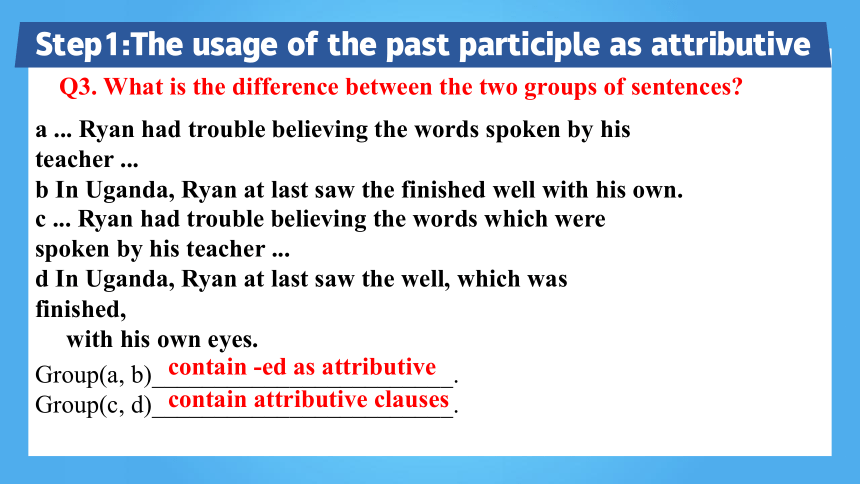
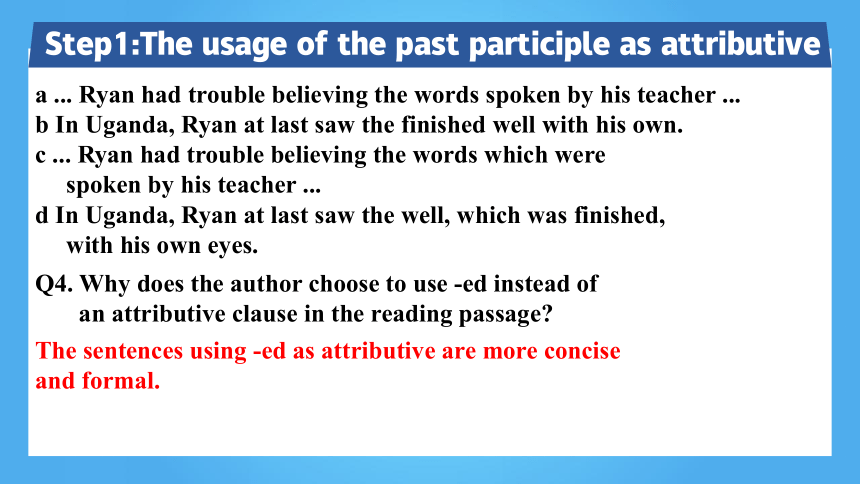
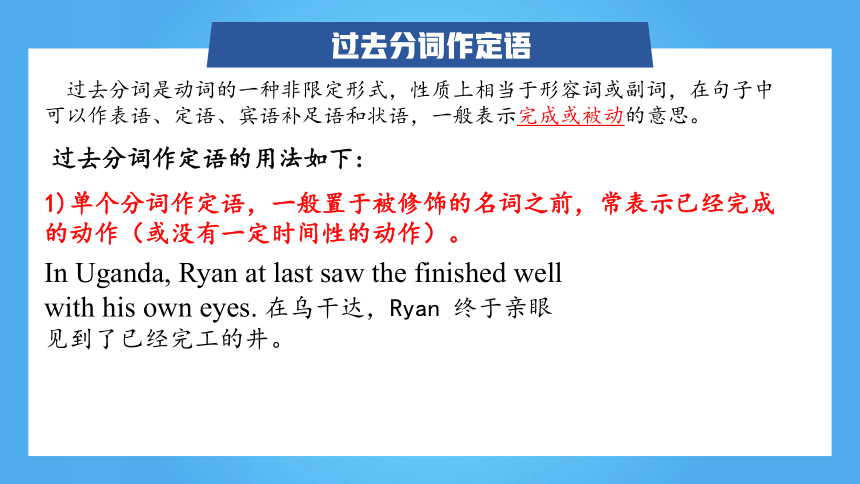
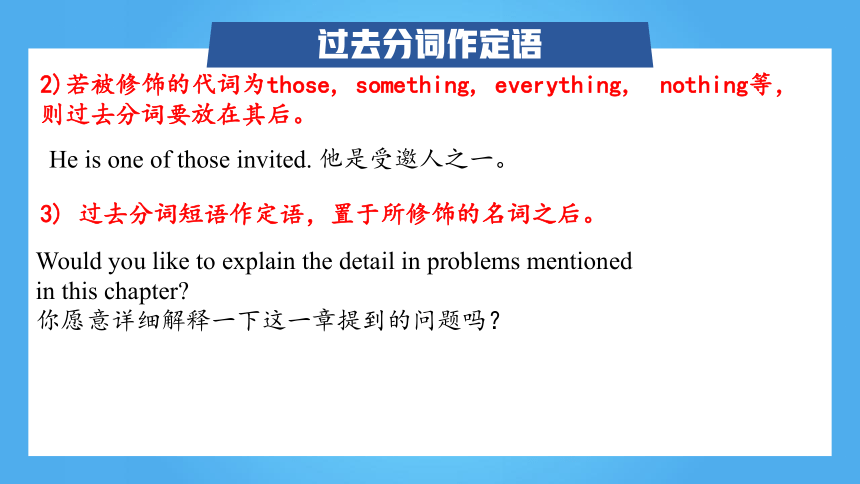
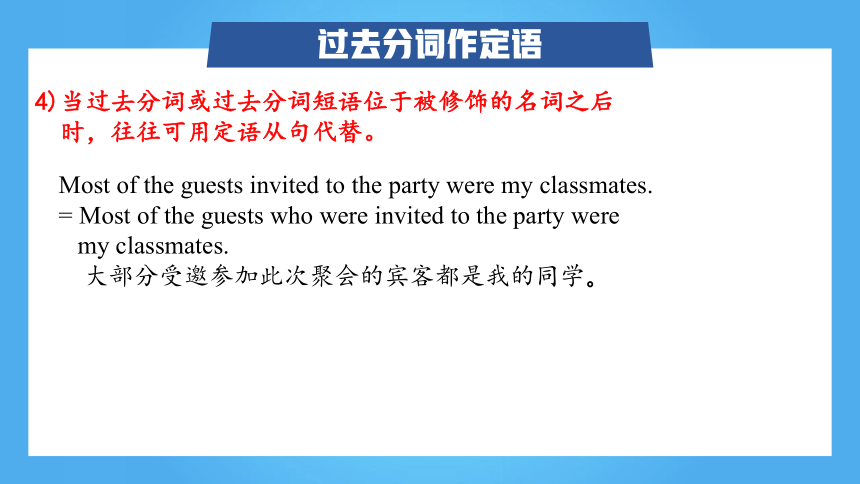
文档简介
(共20张PPT)
-ed as attributive
过去分词作定语
-ed as attributive
过去分词作定语
Learning aims
Students can distinguish the past participle as attributive and the present participle as attributive.
Students can master the usage of the past participle as attributive.
1
2
3
Students can transform the phrases of the past participle as attributive to attributive clause.
a ... Ryan had trouble believing the words spoken by his
teacher ...
b. In Uganda, Ryan at last saw the finished well with his own eyes.
Step1:The usage of the past participle as attributive
Look at the sentences from the reading passage(P15) and answer the questions.
Q1. What was spoken in sentence (a)
What was finished in sentence (b)
a ... Ryan had trouble believing the words spoken by his
teacher ...
b In Uganda, Ryan at last saw the finished well with his own.
Q2. Why does the author use -ed instead of -ing
Because “the words” were “spoken” instead of “speaking”, and “the well” was “finished” instead of “ finishing”. The words in bold show passive instead of active actions.
Step1:The usage of the past participle as attributive
Q3. What is the difference between the two groups of sentences
a ... Ryan had trouble believing the words spoken by his teacher ...
b In Uganda, Ryan at last saw the finished well with his own.
c ... Ryan had trouble believing the words which were spoken by his teacher ...
d In Uganda, Ryan at last saw the well, which was finished,
with his own eyes.
Group(a, b)________________________.
Group(c, d)________________________.
contain -ed as attributive
contain attributive clauses
Step1:The usage of the past participle as attributive
Q4. Why does the author choose to use -ed instead of
an attributive clause in the reading passage
The sentences using -ed as attributive are more concise and formal.
a ... Ryan had trouble believing the words spoken by his teacher ...
b In Uganda, Ryan at last saw the finished well with his own.
c ... Ryan had trouble believing the words which were
spoken by his teacher ...
d In Uganda, Ryan at last saw the well, which was finished,
with his own eyes.
Step1:The usage of the past participle as attributive
过去分词作定语
过去分词是动词的一种非限定形式,性质上相当于形容词或副词,在句子中可以作表语、定语、宾语补足语和状语,一般表示完成或被动的意思。
过去分词作定语的用法如下:
1)单个分词作定语,一般置于被修饰的名词之前,常表示已经完成的动作(或没有一定时间性的动作)。
In Uganda, Ryan at last saw the finished well with his own eyes. 在乌干达,Ryan 终于亲眼见到了已经完工的井。
2)若被修饰的代词为those, something, everything, nothing等,则过去分词要放在其后。
He is one of those invited. 他是受邀人之一。
3) 过去分词短语作定语,置于所修饰的名词之后。
Would you like to explain the detail in problems mentioned in this chapter
你愿意详细解释一下这一章提到的问题吗?
过去分词作定语
4)当过去分词或过去分词短语位于被修饰的名词之后
时,往往可用定语从句代替。
Most of the guests invited to the party were my classmates.
= Most of the guests who were invited to the party were
my classmates.
大部分受邀参加此次聚会的宾客都是我的同学。
过去分词作定语
Step2: Past participle as attributive and attributive clause
Read the discussion and rewrite the underlined sentences using the -ed form.
Step2: Past participle as attributive and attributive clause
Ryan is a young man admired by a lot of people. The money raised by his foundation supports schools and communities in Africa.
As in the words spoken by Ryan, we need to not only donate money but also get new ideas. I think the support needed includes new technology for recycling water and education on how to use and save water.
Step2: Past participle as attributive and attributive clause
Read the passage and choose the correct form of the verbs.
United Nations Children’s Fund, also knowing / known as UNICEF, is a United Nations (UN) organization basing / based in New York. It offers help needing / needed by children all over the world.
UNICEF was founded on 11 December 1946, to provide food and healthcare to children in countries damaging /damaged in World War II. Since 1953, UNICEF has taken up an extended mission to help children in the developing / developed world, including those living / lived with diseases or disabilities, and those affecting / affected by rapid modernisation and environmentalproblems. Now, UNICEF has been working to improve the lives of children and their families across 190 countries and territories.
Step3: Past participle and present participle as attributive
Read the passage and choose the correct form of the verbs.
The United Nations Children’s Fund, also knowing / known as UNICEF, is a United Nations (UN) organization basing / based in New York. It offers help needing / needed by children all over the world.
Step3: Past participle and present participle as attributive
Passive actions:known;based; needed
UNICEF was founded on 11 December 1946, to provide food and healthcare to children in countries damaging /damaged in World War II. Since 1953, UNICEF has taken up an extended mission to help children in the developing / developed world, including those living / lived with diseases or disabilities, and those affecting / affected by rapid modernisation and environmental problems.
Step3: Past participle and present participle as attributive
Active actions:developing;living
高考链接
1. Inspired by the Belt and Road Forum for International Cooperation
( hold ) in Beijing, Cao decided to cover the route by hiking as a tribute to the ancient Silk Road.
2. It can help to build a community with ( share ) future for mankind ," he said .
3. Earth Day , ( mark ) on 22 April , is an annual event aiming to raise public awareness about environmental First protection.
4. I like eating ( fry ) tomatoes with eggs, and I thought it must to be easy to cook.
高考链接
1. Inspired by the Belt and Road Forum for International Cooperation
( hold ) in Beijing , Cao decided to cover the route by hiking as a tribute to the ancient Silk Road.
考查非谓语动词。句意:受到在北京举行的"一带一路"国际合作高峰论坛的启发,曹决定徒步穿越这条路线,以向古代丝绸之路致敬。分析句子可知,本句已有谓语动词 decided ,所以 hold 应用非谓语动词形式, hold 与 cooperation 之间为逻辑动宾关系,应用过去分词,作后置定语,表被动。故填 held 。
2. It can help to build a community with ( share ) future for mankind ," he said .
考查非谓语动词。句意:这有助于构建人类命运共同体。此处为非谓语动词做定语来修饰名词 future 。非谓语动词 share 和名词 future 之间为被动关系,所以用过去分词作定语。故填 shared .
3. Earth Day , ( mark ) on 22 April , is an annual event aiming to raise public awareness about environmental First protection.
解析:地球日于4月22日举行,是一项旨在提高公众环保保意识的年度活动。分析句式可知,设空处是要要做名词Earth Day 的后置定语,且与其之间是是被动关系,要用过去分词。故填 marked。
4. I like eating (fry)tomatoes with eggs , and I thought it must to be easy to cook .
高考链接
【解析】考查非谓语动词。句意:我喜欢吃西红柿炒鸡蛋。动词 fry 与 tomatoes 之间是动宾关系,所以此处应用过去分词作定语,故填 fried
Summary
过去分词作定语的用法如下:
1.过去分词作定语通常表示被动和完成,即被修饰词通常是过去分词所表示的动作的承受者,且该动作已经完成。
2.一般情况下,单个过去分词作定语通常放在被修饰词之前。
3.当过去分词或过去分词短语位于被修饰的名词之后
时,往往可用定语从句代替。
感谢观看
感谢观看
-ed as attributive
过去分词作定语
-ed as attributive
过去分词作定语
Learning aims
Students can distinguish the past participle as attributive and the present participle as attributive.
Students can master the usage of the past participle as attributive.
1
2
3
Students can transform the phrases of the past participle as attributive to attributive clause.
a ... Ryan had trouble believing the words spoken by his
teacher ...
b. In Uganda, Ryan at last saw the finished well with his own eyes.
Step1:The usage of the past participle as attributive
Look at the sentences from the reading passage(P15) and answer the questions.
Q1. What was spoken in sentence (a)
What was finished in sentence (b)
a ... Ryan had trouble believing the words spoken by his
teacher ...
b In Uganda, Ryan at last saw the finished well with his own.
Q2. Why does the author use -ed instead of -ing
Because “the words” were “spoken” instead of “speaking”, and “the well” was “finished” instead of “ finishing”. The words in bold show passive instead of active actions.
Step1:The usage of the past participle as attributive
Q3. What is the difference between the two groups of sentences
a ... Ryan had trouble believing the words spoken by his teacher ...
b In Uganda, Ryan at last saw the finished well with his own.
c ... Ryan had trouble believing the words which were spoken by his teacher ...
d In Uganda, Ryan at last saw the well, which was finished,
with his own eyes.
Group(a, b)________________________.
Group(c, d)________________________.
contain -ed as attributive
contain attributive clauses
Step1:The usage of the past participle as attributive
Q4. Why does the author choose to use -ed instead of
an attributive clause in the reading passage
The sentences using -ed as attributive are more concise and formal.
a ... Ryan had trouble believing the words spoken by his teacher ...
b In Uganda, Ryan at last saw the finished well with his own.
c ... Ryan had trouble believing the words which were
spoken by his teacher ...
d In Uganda, Ryan at last saw the well, which was finished,
with his own eyes.
Step1:The usage of the past participle as attributive
过去分词作定语
过去分词是动词的一种非限定形式,性质上相当于形容词或副词,在句子中可以作表语、定语、宾语补足语和状语,一般表示完成或被动的意思。
过去分词作定语的用法如下:
1)单个分词作定语,一般置于被修饰的名词之前,常表示已经完成的动作(或没有一定时间性的动作)。
In Uganda, Ryan at last saw the finished well with his own eyes. 在乌干达,Ryan 终于亲眼见到了已经完工的井。
2)若被修饰的代词为those, something, everything, nothing等,则过去分词要放在其后。
He is one of those invited. 他是受邀人之一。
3) 过去分词短语作定语,置于所修饰的名词之后。
Would you like to explain the detail in problems mentioned in this chapter
你愿意详细解释一下这一章提到的问题吗?
过去分词作定语
4)当过去分词或过去分词短语位于被修饰的名词之后
时,往往可用定语从句代替。
Most of the guests invited to the party were my classmates.
= Most of the guests who were invited to the party were
my classmates.
大部分受邀参加此次聚会的宾客都是我的同学。
过去分词作定语
Step2: Past participle as attributive and attributive clause
Read the discussion and rewrite the underlined sentences using the -ed form.
Step2: Past participle as attributive and attributive clause
Ryan is a young man admired by a lot of people. The money raised by his foundation supports schools and communities in Africa.
As in the words spoken by Ryan, we need to not only donate money but also get new ideas. I think the support needed includes new technology for recycling water and education on how to use and save water.
Step2: Past participle as attributive and attributive clause
Read the passage and choose the correct form of the verbs.
United Nations Children’s Fund, also knowing / known as UNICEF, is a United Nations (UN) organization basing / based in New York. It offers help needing / needed by children all over the world.
UNICEF was founded on 11 December 1946, to provide food and healthcare to children in countries damaging /damaged in World War II. Since 1953, UNICEF has taken up an extended mission to help children in the developing / developed world, including those living / lived with diseases or disabilities, and those affecting / affected by rapid modernisation and environmentalproblems. Now, UNICEF has been working to improve the lives of children and their families across 190 countries and territories.
Step3: Past participle and present participle as attributive
Read the passage and choose the correct form of the verbs.
The United Nations Children’s Fund, also knowing / known as UNICEF, is a United Nations (UN) organization basing / based in New York. It offers help needing / needed by children all over the world.
Step3: Past participle and present participle as attributive
Passive actions:known;based; needed
UNICEF was founded on 11 December 1946, to provide food and healthcare to children in countries damaging /damaged in World War II. Since 1953, UNICEF has taken up an extended mission to help children in the developing / developed world, including those living / lived with diseases or disabilities, and those affecting / affected by rapid modernisation and environmental problems.
Step3: Past participle and present participle as attributive
Active actions:developing;living
高考链接
1. Inspired by the Belt and Road Forum for International Cooperation
( hold ) in Beijing, Cao decided to cover the route by hiking as a tribute to the ancient Silk Road.
2. It can help to build a community with ( share ) future for mankind ," he said .
3. Earth Day , ( mark ) on 22 April , is an annual event aiming to raise public awareness about environmental First protection.
4. I like eating ( fry ) tomatoes with eggs, and I thought it must to be easy to cook.
高考链接
1. Inspired by the Belt and Road Forum for International Cooperation
( hold ) in Beijing , Cao decided to cover the route by hiking as a tribute to the ancient Silk Road.
考查非谓语动词。句意:受到在北京举行的"一带一路"国际合作高峰论坛的启发,曹决定徒步穿越这条路线,以向古代丝绸之路致敬。分析句子可知,本句已有谓语动词 decided ,所以 hold 应用非谓语动词形式, hold 与 cooperation 之间为逻辑动宾关系,应用过去分词,作后置定语,表被动。故填 held 。
2. It can help to build a community with ( share ) future for mankind ," he said .
考查非谓语动词。句意:这有助于构建人类命运共同体。此处为非谓语动词做定语来修饰名词 future 。非谓语动词 share 和名词 future 之间为被动关系,所以用过去分词作定语。故填 shared .
3. Earth Day , ( mark ) on 22 April , is an annual event aiming to raise public awareness about environmental First protection.
解析:地球日于4月22日举行,是一项旨在提高公众环保保意识的年度活动。分析句式可知,设空处是要要做名词Earth Day 的后置定语,且与其之间是是被动关系,要用过去分词。故填 marked。
4. I like eating (fry)tomatoes with eggs , and I thought it must to be easy to cook .
高考链接
【解析】考查非谓语动词。句意:我喜欢吃西红柿炒鸡蛋。动词 fry 与 tomatoes 之间是动宾关系,所以此处应用过去分词作定语,故填 fried
Summary
过去分词作定语的用法如下:
1.过去分词作定语通常表示被动和完成,即被修饰词通常是过去分词所表示的动作的承受者,且该动作已经完成。
2.一般情况下,单个过去分词作定语通常放在被修饰词之前。
3.当过去分词或过去分词短语位于被修饰的名词之后
时,往往可用定语从句代替。
感谢观看
感谢观看
